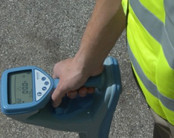When planning just about any construction project, it’s crucial to know what’s below ground. One important thing to locate beneath the surface before breaking ground is any utilities that may be present. GPR, or ground penetrating radar, is a well-used method for locating utilities, especially within or beneath concrete, due to its non-destructive nature and wide variety of applications. While some methods of utility location rely on detecting a magnetic signature, this is often not easily detected through certain materials or in certain conditions, such as concrete. GPR, however, is a very effective method for locating utilities in a variety of settings. Here’s a basic guide to how GPR is used for utility locating.
Locating Utilities
In order to avoid digging up pipes or damaging an electrical system, or even replace an out-of-date system, planners and crews will use a number of methods to locate utilities. Usually, utilities will be mapped out on original plans for a site, but they may be located in a different place on the as-built maps. This can lead crews to trench or dig by hand in order to ascertain the true location of utilities. In other cases, they may use GPR to locate them.
GPR Methods
When using GPR to locate buried utilities, a GPR sensor will be moved over an area systematically in order to mark or map utilities based on the GPR readings. Since GPR relies on sensing the conductivity of materials, metal pipes and wires are ideal for locating by GPR. These utilities will present a different reading from the sensor, allowing crews to mark or map the locations of utilities all over the site. GPR can work to locate utilities in concrete as well as it can in moisture-retaining soil, making it a very versatile method for locating buried utilities.
Marking and Mapping
Depending on the needs of a particular site, a crew may need to mark or map utilities. Mapping is much larger-scale, often requiring that an entire site be scanned in order to map all the readings across the area, typically by a grid GPR survey. But some sites may simply require a “locating and marking” methodology, where the sensor will be used in an area that is likely to be a utility location. This is the most common way of using GPR to locate utilities.
GPR Services from Concrete Visions
Concrete Visions has over 12 years of experience and expertise in concrete scanning and we know how to detect any problems lurking beneath the surface. We use ground penetrating radar accurately and expertly and are familiar with many other methods that can be used when appropriate like concrete x-ray and electromagnetic conductivity. We are also very familiar with the latest construction safety techniques and train all of our workers to do their work quickly, accurately, and safely. If you would like to learn more about how we can help you, give us a call at (410) 766-2210 or visit us online. For more articles and tips, follow us on Facebook, Twitter, LinkedIn, and Google+.

